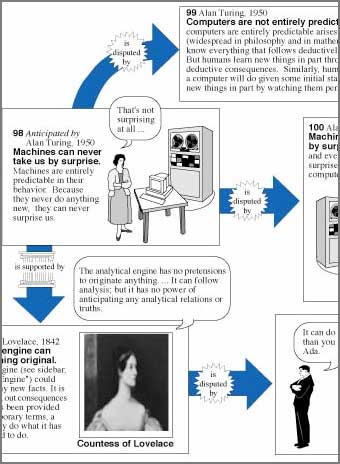Issue Maps!
August 20th, 2010
Here’s another fun one to throw into the “Is it Comics?” basket: illustrated issue maps like this one.
An easy “no” in cases where it’s just words (like in this classic from Mr. F) but a more interesting question when the pictures do more of the talking.
If you go far enough, would it start to look a little more like this?
[Thanks to Dafna from Carnegie Mellon for reminding me of these crazy, wonderful charts]
Posted in Visual Communication















Well, this isn’t unlike something Chris Ware might do. I’ve seen comics with almost full pages of intermittent text.
Is it comics? Are we losing our grasp of a working definition? Even yours? Why is the medium so hard to pin down when we can definitely say a film is a film or a novel is a novel? Or am I just ignorant to the issues therein?
I’ll say yes, it’s comics. As soon as you have a speech bubble coming out of any image, you imagine them speaking, and thus starts the displacement of flowing vs static time, anthropamorphicism, etc.
Actually, I’m pretty sure “novel” has been getting a thorough working-over for a very long time. ^^
Any definition is going to be elusive the more we try to pin it down; mine included.
Hm… according to some book I read once (understanding… something ;)), I think this could qualify as comics. But may I dare to ask… isn’t that definition a little broad? Wouldn’t drawing a line be beneficial to the art of comics somehow?
I personally don’t feel (because it’s more of a feel thing than anything) this should be considered comics. Maybe it’s because it’s just one step up from a flowchart, and I just refuse to consider the flowcharts I have to watch at work the same thing than the comics I read at home. The map in display is a cleverly structured piece of information, but a comic… no, I don’t consider it a comic.
The reason I’m inclined to lean on the “yes” side, in this case, is simply that without a change in the basic structure of the thing, I can imagine a talented cartoonist creating a pretty good comic from this template.
And if oddball discussions like this were to someday lead to even one good comic being dreamed up, it’s worth posing the question. ^^
As much as I’d love to agree with you that flow charts aren’t comics, I have to disagree to some extent in this case because of the visuals but more so than that, there is the issue of the passage of time and the chronology of a story. In this case it is the story of an argument/though process.
The “events” are chronological if when you read them in “sequence” (I’m putting that in quotes only because I don’t know how to italicize here).
I mean, I’d like to agree with you, but this almost in effect screams comics. My stomach churns at flow charts as well but maybe this is simply a comic you don’t like.
BTW: For italics, you can use the standard html tags.
[tried to demonstrate using the “plaintext” tag here in comments, but THAT tag seems to freak out WordPress.]
[i]YES![/i]
aw…
This one: <
Try to Google lexivisual or lexivisuell.
First time I read “levisexual” u_u My mind is playing tricks on me…
Thanks for the tip! I found a neat essay. It only confirms my own “thesis” (those damn quotation marks!) that this is indeed a comic. At the very least, it speaks the language…
Something else to throw into the “Is it comics?” basket: http://www.boingboing.net/2010/08/10/yakuza-3-review.html. It’s sequential, it’s words and pictures, and somehow the sum of its parts equals more than just an essay. Love it.
The term ‘infographics’ come to mind. Infographics can use endless varieties of graphic styles and graphic medium including comics. So while it may or may not be comics, it’s definetely infographics.
Infographics and lexivisuality …
Not comics. It uses elements that comics use (in fact, comics created them), it has the sequential aspects (as texts also have them) and it shows illustrations. So, it may look like comics, but it’s something else.
if it walks like a duck and talks like a duck… it’s comics.
Looks like sequential storytelling to me. The info-graphic may be considered a genre more educational than entertaining appealing to an atypical comicbook audience.
Perhaps we are looking at this too black and white. Maybe the question isn’t “Is this comics” but “What percent of this is comics?” Whenever you try to push a definition to its limit you end up with this problem. Consider this:
http://ncse.com/image/fossilhomslabeled
Its impossible to pick a single generation as the point we became human. Richard Dawkins talks about this in an essay that can be found here:
http://www.animal-rights-library.com/texts-m/dawkins01.htm
Comics suffer from this same dilemma. I will say that it is a little worse for comics because the intermediates aren’t extinct. In Understanding Comics you wrote something along the lines of film being comics before it is projected. Consider this mental exercise: Take your favorite peanuts strip. separate all the panels into a book like arrangement. Nobody would debate that this is comics. Now, add an intermediate panel between each other panel. Keep doing this until you have a convincing flipbook. Is it animation or a comic? Both? If its still a comic then we should be able to put it on the computer and have it still be a comic, as we do that with other comics and still treat them as such. If we now play it as a slideshow we have a slow silent cartoon or a slow comic. Take your pic. Speed up the slideshow and we have what is undeniably animation. Sorry if this didn’t make much sense. I just woke up or rather am still asleep. This too seems to be a blurry distinction.
Sorry, but if you take a comic strip and separate all the panels into pages making a flip book, you have a flipbook, not comics. If you take the panels and make a slide show or a silent animation, then you got no comics anymore. Comics were just the origin of your work. Hamburger isn’t cow anymore.